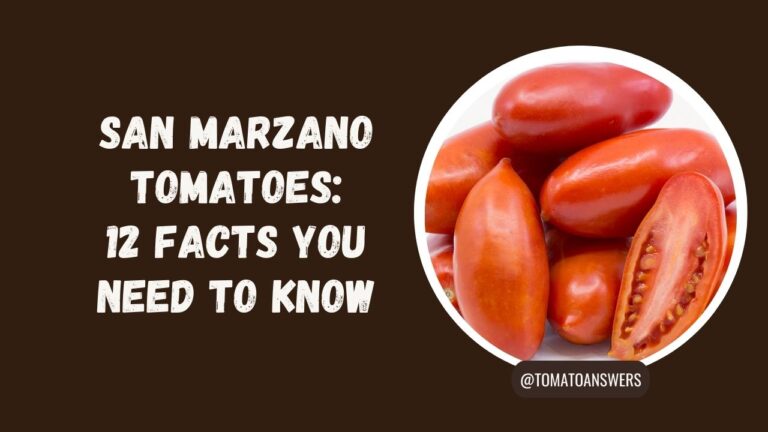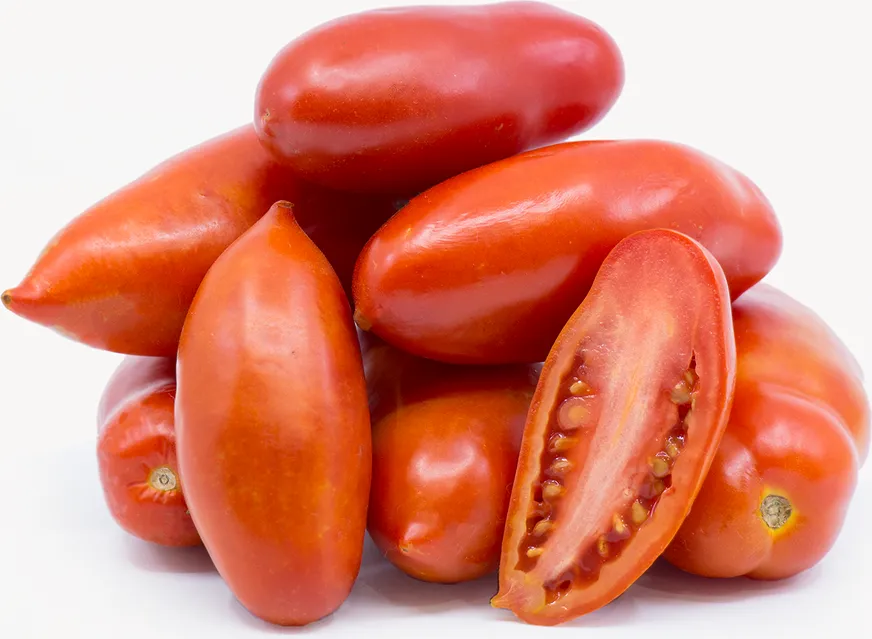In This Article
San Marzano Tomatoes: 12 Facts You Need to Know
San Marzano tomatoes taste really sweet and flavorful. They have the perfect amount of sourness. Their flesh is thick, tender, yet firm. San Marzano tomatoes are bursting with intense, sun-ripened flavor.
San Marzano tomatoes are juicy but not watery, so they make excellent sauces. Their connection to traditional farming in Italy paints a romantic picture of peaceful countryside living. Some people think they are essential, while others see them as a luxury item.
People purchase them by the case. Certain recipes specifically call for San Marzano tomatoes by name. There are entire brands dedicated to these tomatoes.
Some brands proudly claim to offer authentic San Marzano tomatoes. San Marzano is a region, a type of tomato, a plant variety, a brand name, and a consortium.
There is a lot of hype and confusion surrounding these exceptional tomatoes. What are the facts? Let’s break down everything you need to know about San Marzano tomatoes.
Fact#1: It’s A Specific — And Highly Sought Variety Of Tomato
A San Marzano tomato is a specific type of plum tomato. It has been bred over the years for its packaging and long shelf life.
Other well-known varieties of plum tomato include Big Mama, Amish Paste tomato, and Roma tomato.
San Marzano tomatoes look similar to Roma tomatoes but are thinner and more pointed. They have thicker walls, so they are meatier.
San Marzanos have fewer seeds than typical tomatoes. This means they have a thicker, less watery interior, making them great for tomato sauce. San Marzanos also have a stronger, sweeter flavor than Roma tomatoes.
Fact#2: They Are Grown In A Specific Place.
San Marzano tomatoes are grown in a small area in the Campania region of southern Italy. This area is between Naples and Salerno. It is known as Agro Nocerino-Sarnese.
It is located in the Sarno River valley near Mount Vesuvius, primarily in the Province of Salerno.
The tomatoes are named after the city of San Marzano sul Sarno, one of the 41 towns in the growing region.
Fact#3: Agro Nocerino-Sarnese Has Perfect Growing Conditions.
The Italian government considers the growing region very important for this variety of tomatoes.
In 1996, they gave San Marzano tomatoes an official Protected Designation of Origin (DOP). This certification guarantees the tomatoes come from a specific place.
The growing conditions in Agro Nocerino-Sarnese are considered ideal for San Marzanos. The tomatoes thrive in a warm, humid climate.
The ideal temperature is between 50 and 95 degrees Fahrenheit. The Sarno Valley also has abundant water sources and consistent humidity levels.
The valley’s proximity to Mount Vesuvius gives it mineral-rich volcanic soils with phosphorous and potassium. These fertile soils produce sweeter, less acidic tomatoes.
Fact#4: Not All Italian Tomatoes Are San Marzanos.
Many other types of tomatoes are grown throughout Italy and canned for export. Some well-known varieties include cherry tomatoes, bulgy heirloom beefsteak tomatoes, and Roma tomatoes.
Each type has a different taste and consistency, suitable for different purposes.
For example, pomodorini is a sweet cherry tomato with a fresh flavor. Costoluto Fiorentino beefsteaks are juicy and slightly more acidic, often eaten raw.
While all San Marzano tomatoes are Italian, not all Italian tomatoes are San Marzanos.
Fact#5: Non-DOP San Marzanos are sold in the U.S.
Non-DOP San Marzanos (grown outside the designated region) are sold in the United States. As the variety has become more popular, demand has increased.
Some companies now grow San Marzano tomato plants outside the designated region to meet this demand.
These may be labeled as “San Marzano-style” tomatoes or just called “San Marzano tomatoes,” but they won’t have the DOP label certifying their origins. While they are the same plant, growing conditions can affect the flavor.
Fact#6: You Can Try Growing San Marzano-Style Tomatoes In Your Home Garden
If you’re not concerned about the DOP designation, you can grow San Marzano tomatoes from seeds in your home garden.
The seeds are widely available for purchase. While not considered true San Marzano tomatoes (since they’re grown outside the Agro Nocerino-Sarnese region), the plants are the same as the ones grown in Italy.
To grow them at home, select a site with six to eight hours of full sun daily.
Add compost, peat moss, or manure to mimic the fertile volcanic soil.
Feed them with a low-nitrogen fertilizer and provide plenty of water, but not too much to waterlog the soil. After three months, you’ll have a lovely crop of delicious, saucy tomatoes.
Fact#7: There Are Frauds And Fakes On The Market
Many tomatoes labeled as San Marzanos in the U.S. are not real San Marzanos. The DOP is a European Union law, so the rules around the label and name are not as strict in the U.S.
Only about 5% of the San Marzano tomatoes sold in the U.S. are the real deal.
To identify real San Marzanos, look for the yellow and red DOP seal with the words “Denominazione d’Origine Protetta” on the can.
You may also find an IGP (Indicazione Geografica Protetta) label, which is legitimate but less strict than the DOP certification. Unfortunately, some companies wrongly apply the DOP seal or use the San Marzano name on other tomato varieties.
Authentic cans must say “Pomodoro San Marzano dell’Agro Sarnese Nocerino” and have the DOP seal and a Consorzio San Marzano certification number on the bottom.
Fact#8: Non-Industrialized Growing And Production Contributes To Their Expense
The DOP certification enforces rules about the growing conditions, harvest, and processing of San Marzano tomatoes.
The San Marzano Tomato Protection Consortium mandates that the tomatoes must be harvested exclusively by hand between July 30 and September 30.
It is forbidden to use any artificial means of ripening. The tomatoes must ripen naturally and be picked in stages as they ripen on the vine.
Since they can only be harvested seasonally during a short window each year, and the process is labor-intensive, this contributes to the high price of San Marzano tomatoes.
Fact#9: San Marzanos Are Minimally Processed
San Marzano tomatoes are left very close to their natural state. They are canned, but remain pure and unadulterated.
Under the DOP rules, San Marzanos can have no preservatives or filler ingredients — only salt and optional fresh basil leaves.
They are not legitimate DOP San Marzano tomatoes if they can contain garlic, citric acid, or other ingredients besides tomatoes, salt, and basil. This minimal processing means the tomatoes arrive in the can still fresh-tasting, robust, and flavorful.
Fact#10: You Can Only Buy Them Whole Or Halved.
The San Marzano Tomato Protection Consortium mandates that the tomatoes be processed in one of two ways: whole peeled tomatoes or peeled tomatoes in fillets (cut in half with the inner ribs removed).
There are no other options for a DOP-compliant San Marzano tomato.
If the canned tomatoes are pureed, diced, or chopped, they are not true San Marzanos. Leaving them whole or halved allows these tender fruits to hold their shape during storage and release their savory juices when crushed during cooking.
Fact#11: Traditional Neapolitan Pizza Calls For San Marzanos
Neapolitan cuisine has a long history with tomatoes.
Neapolitans were among the first Europeans to embrace tomatoes for cooking. In 1889, the Neapolitan pizza was invented using local tomatoes, basil, and cheese.
Today, Neapolitan pizza (Pizza Napoletana) is a UNESCO Cultural Heritage food.
The most classic example is the Margherita pizza. Italian standards specify that the only acceptable tomatoes for a Neapolitan pizza are Pomodorino Vesuviano and San Marzanos.
Fact#12: Dishes That Feature Big Tomato Flavors Are The Best Use For San Marzanos
San Marzano tomatoes have a powerful flavor, so they are best in dishes that highlight tomatoes as the star ingredient.
Use them in a classic red sauce, like scarpariello or puttanesca. They would make an excellent base for a vodka sauce or even a bloody mary.
Use them as the sauce in baked dishes like lasagna, eggplant Parmesan, or classic manicotti, and see how these tomatoes enhance the experience. While Italian foods are the most obvious choice, San Marzanos also work well in other cuisines.
Video: The Untold Truth Of San Marzano Tomatoes
FAQs About San Marzano Tomatoes
What gives San Marzano tomatoes their distinctive flavor?
The fertile volcanic soil, warm climate, and specific growing region of Agro Nocerino-Sarnese in Italy give San Marzano tomatoes their prized, robust, sweet taste.
What is the difference between San Marzano and Roma tomatoes?
San Marzanos are thinner, pointier, and meatier with thicker walls and fewer seeds than the stout Roma tomato. They also have a stronger, sweeter tomato flavour.
Can any canned tomatoes be labeled as San Marzanos?
No, for tomatoes to be authentic San Marzanos they must have DOP certification proving they were grown in the designated region of Italy under specific guidelines.
Are imported San Marzano tomatoes always more expensive?
Yes, the non-industrialized growing methods like hand-harvesting during a limited season contribute to higher costs, along with limits on maximum production levels imposed by DOP rules.
How can you identify real San Marzano tomatoes?
Look for cans with the DOP seal, Italian wording like “Pomodoro San Marzano dell’Agro Sarnese Nocerino,” and a certification number indicating they meet all requirements.
What dishes benefit most from using San Marzano tomatoes?
Dishes where tomatoes are the star ingredient showcase San Marzanos’ robust flavour best, like tomato sauces, soups, baked pasta, Neapolitan pizza, and certain ethnic foods.
Can San Marzano tomatoes be grown successfully outside of Italy?
While the seeds can be planted elsewhere, to be considered true San Marzano tomatoes they must be grown in the specific Agro Nocerino-Sarnese region with its unique climate and soil.
Why are San Marzanos often canned whole or in halves?
The DOP rules mandate San Marzanos can only be processed as whole peeled tomatoes or tomato halves with no other preparations allowed to maintain their shape and texture.
Do all canned Italian tomatoes need to follow DOP guidelines?
No, the DOP regulations only apply specifically to San Marzano tomatoes from the Agro Nocerino-Sarnese region. Other Italian tomato varieties have different guidelines.
What are Other tomatoes approved for Neapolitan pizza?
Besides San Marzanos, the only other tomato variety allowed on authentic Neapolitan pizza is the Pomodorino Vesuviano, another local Italian variety.


